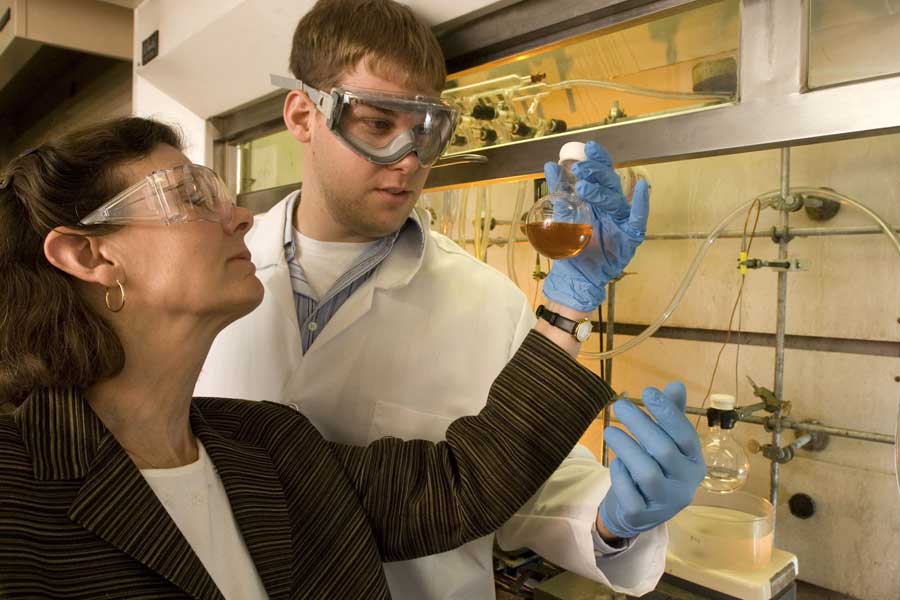ICTAS announces thrust on nano-biomaterials

Four innovative interdisciplinary programs connecting nanotechnology and health care are receiving initial seed funding from Virginia Tech’s Institute for Critical Technology and Applied Science (ICTAS). The four areas will come under one of the designated primary research thrusts within ICTAS, “Nano-Biomaterials for the Delivery of Therapeutic and Diagnostic Agents.”
As scientists and engineers unfold the understanding of materials at the nanoscale level, a “tremendous potential for major discoveries in healthcare exists,” said Judy Riffle, professor of chemistry and leader of the effort.
“In response to the potential for discovery and creativity in nano-medicine, and the need for educating graduate students with the interdisciplinary skills to improve the manner in which devastating diseases are treated and monitored, Virginia Tech is well positioned to build a world-class program in nano-biomaterials as an interface to nanotechnologies in the medical field,” Riffle added.
Consequently, ICTAS is funding efforts in four related areas in the interdisciplinary field of nano-biomaterials. The first is targeted drug delivery to treat diseases due to intracellular bacterial pathogens and cancer. The second relates to using specific nanocrystals, labeled bioconjucated cellulose, for immuno-targeting. In the third area, researchers will perform micro-injection of nanoparticles and use real-time spectroscopy in biological systems. The last focus area is engineered nanoconstructs for targeted regulation of intracellular free radical concentration.
The Virginia Tech team of researchers will include chemists and physicists who have traditionally studied materials at the atomic (angstrom) level, and who now are striving to synthesize supramolecular constructs to impact cellular and biological interactions that depend on the larger nanoscale. The team will also include biologists and engineers who have studied macroscopic properties, and are now working to understand the fundamental underlying aspects of structures and disease at a smaller scale.
Virginia Tech’s nationally ranked macromolecular program (fifth nationally), the Virginia-Maryland College of Veterinary Medicine, the Wake Forest-Virginia Tech School of Biomedical Engineering and Science, the biomedical research programs at the Virginia College of Osteopathic Medicine, and others on campus will combine their efforts under the ICTAS umbrella to work in this interdisciplinary thrust.
“It is clear that a melding of expertise among the physical scientists/engineers, and biologists/MDs/veterinarians/biomedical engineers could exploit nanomedicine in a far more efficient manner than any of these professionals can do alone,” Riffles said.
The U.S. government invested approximately $4 billion in nanotechnology between 2001-2005. Notably, the first President’s Council of Advisors on Science and Technology (PCAST) review of the U.S. nanotechnology initiative in 2005 concluded that the U.S. leads globally in nanotechnology, but it feared that the U.S. was not producing enough scientists and engineers to carry the field forward.
Approximately 7000 square feet of interdisciplinary space housing three laboratories (nano-biomaterials synthesis, nano-biomaterials characterization of morphology and structure, and nano-medical research) will be dedicated to this effort in the ICTAS I building currently under construction on campus. It is envisioned that the effort will be expanded into the full Virginia Tech Nano-Biomaterials effort in the ICTAS II facility planned for 2010.
A “working group” of Virginia Tech faculty has formed for the purpose of identifying outside funding sources and developing productive collaborations to augment and grow the initiative. Faculty who may be interested in participating should contact Judy Riffle, her assistant, Angie Flynn, or ICTAS Director, Roop Mahajan.



.jpg.transform/m-medium/image.jpg)
